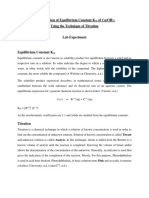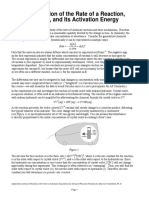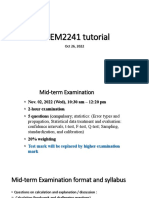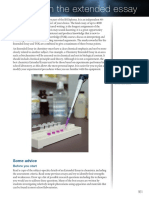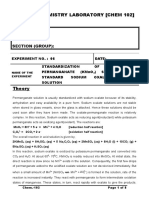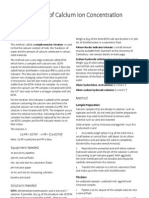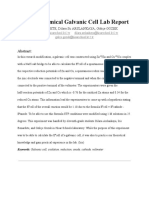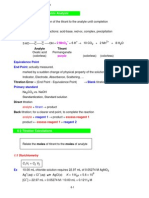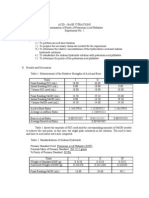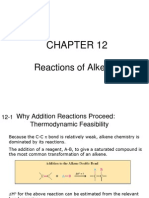Titration Curves Lab Report
Titration Curves Lab Report
Uploaded by
api-584392101Copyright:
Available Formats
Titration Curves Lab Report
Titration Curves Lab Report
Uploaded by
api-584392101Original Title
Copyright
Available Formats
Share this document
Did you find this document useful?
Is this content inappropriate?
Copyright:
Available Formats
Titration Curves Lab Report
Titration Curves Lab Report
Uploaded by
api-584392101Copyright:
Available Formats
Olivia Martin, Lindsay Koepke, Titration Curves, 04/12/2021
Procedures
This titration curves lab entailed using our skills in titration to generate an acid-base titration curve. The
lab started with standardizing a sodium hydroxide solution. From there we generated a titration curve for
the titration of our weak acid with a strong base and determined the equivalence point. Lastly, we
calculated the initial concentration of the weak acid and the Ka for the weak acid using our data from the
titration. The purpose of this lab was to practice using titrations and equivalence points to calculate the
pH. This is important because it provides a better understanding of how the equivalence point relates to
the Ka value.
Results
Titration Curve:
Standardization of NaOH
Trial 1 Trial 2 Trial 3
Mass of KHP 0.501 g 0.501 g 0.501 g
Final buret reading, NaOH 16 mL 32 mL 48 mL
Initial buret reading, NaOH 0 mL 16 mL 32 mL
Total volume, NaOH 16 mL 16 mL 16 mL
Molarity of NaOH 0.153125 0.153125 0.153125
Average molarity of NaOH 0.153125
Initial pH of acid solution: 2.03
Volume of NaOH solution required to reach equivalence point: 34.5 mL
pH at equivalence point: 10.12
Initial concentration of acid: (2.45 x 10^-3) / (0.016) = 0.153125
½ volume of base required to reach equivalence point: 17.25
pH of solution at this half-way point: 2.70
Interpretation of Data & Conclusion
There were no issues or mistakes that I am aware of from this lab. From the titration curve and other
information gathered from this experiment, it can be determined that unknown 7 is a strong acid and
NaOH is a strong base. The equivalence point helps confirm this observation (shown in the photo of the
titration curve). The recording of pH time intervals helped to find the equivalence point since the change
in pH value is very evident, (34.5 mL, pH 5.0 - pH 10.12), which indicates the equivalence point.
Ka Calculations:
Ka initial: 0.153125/2.03 = 0.07543103448
Ka halfway: 2.70/17.25 = 0.1565217391
The Ka values have a difference of 0.08109070465. The Ka value for the halfway point is greater than the
Ka value for the first full equilibrium point.
You might also like
- Year 9 Mathematics Spring White Rose Higher BDocument12 pagesYear 9 Mathematics Spring White Rose Higher BAyaan Qureshi100% (1)
- Experiment 4A - Cu (II) Analysis by Spectrophotometry - Report FormDocument11 pagesExperiment 4A - Cu (II) Analysis by Spectrophotometry - Report FormEdvair Filho100% (1)
- Determination of KC For An Esterification Reaction ReportDocument5 pagesDetermination of KC For An Esterification Reaction ReportTuo Hundou Lee100% (3)
- Equilibrium Constant For Hydrolysis Lab6finalDocument9 pagesEquilibrium Constant For Hydrolysis Lab6finalapi-534386927No ratings yet
- BT HPTDocument31 pagesBT HPTLinh NguyenNo ratings yet
- Lab Report Acid BaseDocument4 pagesLab Report Acid Basexuni34No ratings yet
- Quantitative Determination of Citric and Ascorbic Acid WDocument3 pagesQuantitative Determination of Citric and Ascorbic Acid Wblackjiriu100% (1)
- Chemical Kinetics: The Iodine Clock Reaction: J. CortezDocument6 pagesChemical Kinetics: The Iodine Clock Reaction: J. CortezKyle CortezNo ratings yet
- Experiment 3 Redox Titration Percent Purity AnalysisDocument5 pagesExperiment 3 Redox Titration Percent Purity AnalysisnanaNo ratings yet
- Lab6 S06 Bleach - Kinetics PDFDocument7 pagesLab6 S06 Bleach - Kinetics PDFMariana CasasNo ratings yet
- 8 - Lab8-Potentiometric Titration of Acid MixtureDocument6 pages8 - Lab8-Potentiometric Titration of Acid MixtureHoang Huong TraNo ratings yet
- Determining Equilibrium Constant Lab-U3Document7 pagesDetermining Equilibrium Constant Lab-U3Muhamamd IdreesNo ratings yet
- CHM12 Experiment 5 KineticsDocument15 pagesCHM12 Experiment 5 Kineticsshaam030% (2)
- Nestle Lanka PLC Project Eco Packaging: 1. Capital BudgetingDocument5 pagesNestle Lanka PLC Project Eco Packaging: 1. Capital BudgetingSara100% (1)
- Burning and Nodulization Process of Clinker in The Rotary Kiln As Viewed From The Fine Textures of The Constituent MineralsDocument6 pagesBurning and Nodulization Process of Clinker in The Rotary Kiln As Viewed From The Fine Textures of The Constituent MineralsAnonymous NxpnI6jCNo ratings yet
- Repair Denso PumpsDocument77 pagesRepair Denso PumpsAka Diesel93% (15)
- Lab Report 4 Phd124 Update FinishedDocument13 pagesLab Report 4 Phd124 Update FinishedNUR ALYA BATRISYIA ZUKMINo ratings yet
- Chem A 17 Comp Beers LawDocument5 pagesChem A 17 Comp Beers LawJahnabi DasNo ratings yet
- FR AnachemDocument5 pagesFR AnachemYüri ÄnnNo ratings yet
- 05 Determining The Molar Volume of A GasDocument8 pages05 Determining The Molar Volume of A Gaslouise50% (4)
- VinegarDocument14 pagesVinegarLynn HeimatotoNo ratings yet
- 12 Determination of The Order of A Chemical Reaction and Its Activation EnergyDocument25 pages12 Determination of The Order of A Chemical Reaction and Its Activation EnergyZamri FadilahNo ratings yet
- Chemistry 112 Dye Kinetics Laboratory 2011Document4 pagesChemistry 112 Dye Kinetics Laboratory 2011Lavenia Alou MagnoNo ratings yet
- Vibilan Jayanth - Chemistry IADocument14 pagesVibilan Jayanth - Chemistry IAjennaNo ratings yet
- Stability Studies of Lysine Acetylsalicylate (Aspirin Derivative) : Mechanisms of HydrolysisDocument8 pagesStability Studies of Lysine Acetylsalicylate (Aspirin Derivative) : Mechanisms of Hydrolysisedwardoll100% (1)
- Iodimetric Titration: Aim: PrincipleDocument2 pagesIodimetric Titration: Aim: PrincipleHarsh ThakurNo ratings yet
- The Acid Dissociation ConstantDocument21 pagesThe Acid Dissociation ConstantLarry Villones Jr.100% (1)
- Cape Chemistry Lab CompressDocument6 pagesCape Chemistry Lab CompressDesmond Jones100% (1)
- Practical Guide Edexcel2Document42 pagesPractical Guide Edexcel2Hady JawadNo ratings yet
- The Calorimetric Determination of Manganese in Paper ClipsDocument4 pagesThe Calorimetric Determination of Manganese in Paper ClipsOnkarabile Matome100% (1)
- AQA GCSE Chemistry Combined U2 Bonding Structure and Properties of Matter Knowledge OrganiserDocument3 pagesAQA GCSE Chemistry Combined U2 Bonding Structure and Properties of Matter Knowledge Organisergundavannessa27No ratings yet
- Statistics - Review 26 Oct 2022Document31 pagesStatistics - Review 26 Oct 2022Tsz Wun CHOWNo ratings yet
- DiscussionDocument3 pagesDiscussionSiti HajarNo ratings yet
- Prescribed Practicals Lab Manual 2016Document28 pagesPrescribed Practicals Lab Manual 2016rbgrossNo ratings yet
- Lab Experiment 3 Ka Determination Through PH TitrationDocument4 pagesLab Experiment 3 Ka Determination Through PH TitrationxmusiqaNo ratings yet
- EE For IB HLDocument7 pagesEE For IB HLValletek LynxXNo ratings yet
- Acid Base TitrationDocument4 pagesAcid Base TitrationNeeta PandeyNo ratings yet
- Experiment 2: Complexometric Titration 1.0 ObjectivesDocument4 pagesExperiment 2: Complexometric Titration 1.0 ObjectivesSangetha ChelladoraiNo ratings yet
- VO (Acac) 3Document34 pagesVO (Acac) 3Vinay GautamNo ratings yet
- Copper Determination in Water by Standard Addition PotentiometryDocument4 pagesCopper Determination in Water by Standard Addition PotentiometryAura Ballesteros MontealegreNo ratings yet
- LAB GravimetricAnalysisSulfateMixtureDocument3 pagesLAB GravimetricAnalysisSulfateMixtureDNo ratings yet
- Chemistry 232 Water Hardness: EDTA Titrimetric Method: PurposeDocument4 pagesChemistry 232 Water Hardness: EDTA Titrimetric Method: PurposekuochsochinNo ratings yet
- Fe SADocument5 pagesFe SASashi Thilak100% (1)
- Ionisation EnergyDocument4 pagesIonisation EnergyAvigyaNo ratings yet
- Joshua Haholongan - Science Rate of Reaction ReportDocument13 pagesJoshua Haholongan - Science Rate of Reaction ReportJoshua HaholonganNo ratings yet
- Exp 6 (Solved) 1Document8 pagesExp 6 (Solved) 1mahmudulNo ratings yet
- Titus John - Enthalpy Prac ReportDocument12 pagesTitus John - Enthalpy Prac Reportapi-295071132No ratings yet
- F325 Acids and PHDocument19 pagesF325 Acids and PHDoc_CrocNo ratings yet
- Lab Write-Up Format 2025Document3 pagesLab Write-Up Format 202525lliNo ratings yet
- Unit 2 NotesDocument28 pagesUnit 2 NotesMuhammad ZaiNo ratings yet
- CalciumDocument3 pagesCalciumMuhammad Amir AkhtarNo ratings yet
- AP Chem Lab Report - Galvanic CellDocument8 pagesAP Chem Lab Report - Galvanic CellGokce GozekNo ratings yet
- Experiment 1: CalorimetryDocument4 pagesExperiment 1: CalorimetryNeil Mark EnriquezNo ratings yet
- Chemistry PracticalsDocument77 pagesChemistry PracticalsSyed Athiq PashaNo ratings yet
- Redox Titration of Ferri To Ferro Illustrating The Nernst Eq and Beer's LawDocument3 pagesRedox Titration of Ferri To Ferro Illustrating The Nernst Eq and Beer's LawAlex NavaNo ratings yet
- Phy Chem 3 Past Questions 2011 - 2012Document45 pagesPhy Chem 3 Past Questions 2011 - 2012Clement ThabangNo ratings yet
- Kineticsss Notes PDFDocument73 pagesKineticsss Notes PDFArun SharmaNo ratings yet
- 6 Good Tritration PDFDocument5 pages6 Good Tritration PDFUjak KimiaNo ratings yet
- StoikhiometriDocument89 pagesStoikhiometrikembar ayu100% (2)
- Acid Base Titration (Theory) - Inorganic Chemistry Virtual Lab - Chemical Sciences - Amrita Vishwa Vidyapeetham Virtual LabDocument8 pagesAcid Base Titration (Theory) - Inorganic Chemistry Virtual Lab - Chemical Sciences - Amrita Vishwa Vidyapeetham Virtual Labpankaj111No ratings yet
- Complexometric Titration of ZincDocument1 pageComplexometric Titration of ZincMireliz Corilloclla100% (1)
- ACID - BASE TITRATIONS Determination of Purity of Potassium AcidDocument4 pagesACID - BASE TITRATIONS Determination of Purity of Potassium Acidhilary0622No ratings yet
- Data SheetDocument5 pagesData Sheetkyle javierNo ratings yet
- ANAS - Anal ChemDocument12 pagesANAS - Anal Chemnoraliah 21No ratings yet
- PowerFit in EnglishDocument35 pagesPowerFit in EnglishJoe ScopeliteNo ratings yet
- Node - JS HandbookDocument189 pagesNode - JS HandbookRamses Garate100% (1)
- Pointers in C PresentationDocument105 pagesPointers in C PresentationManish Gurjar100% (1)
- Astm 531Document5 pagesAstm 531JOSEPH REFUERZONo ratings yet
- Intel DPDK Api Reference PDFDocument353 pagesIntel DPDK Api Reference PDFkamal710229No ratings yet
- Holt Pre Algebra Homework and Practice Workbook PDFDocument8 pagesHolt Pre Algebra Homework and Practice Workbook PDFcan3z5gx100% (1)
- Review EmbankmentDocument4 pagesReview EmbankmentHa NaNo ratings yet
- Recent Progress On Long Service Life Design of Chinese Blast Furnace HearthDocument11 pagesRecent Progress On Long Service Life Design of Chinese Blast Furnace HearthSaumit PalNo ratings yet
- Different Types of Computer Storage DevicesDocument4 pagesDifferent Types of Computer Storage DevicesMuhammad Naveed25% (4)
- Conveyor Belt StandardsDocument7 pagesConveyor Belt Standardssuraia100% (2)
- Differential Equations PDFDocument20 pagesDifferential Equations PDFAlaviNo ratings yet
- ALV Object Model - Simple 2D Table - Event Handling: Applies ToDocument12 pagesALV Object Model - Simple 2D Table - Event Handling: Applies ToSastryNo ratings yet
- Equivalent Eccentricity Method - Column Design Using Mathcad PrimeDocument2 pagesEquivalent Eccentricity Method - Column Design Using Mathcad PrimeYan YanNo ratings yet
- Process and Synchronization (Problems: Race Condition and Deadlock)Document36 pagesProcess and Synchronization (Problems: Race Condition and Deadlock)Dimas setyaNo ratings yet
- SimSwap Towards Faster and High-Quality Identity SwappingDocument17 pagesSimSwap Towards Faster and High-Quality Identity SwappingNainaNo ratings yet
- E Bicikli Xplorer Mini UPUTSTVO PDFDocument66 pagesE Bicikli Xplorer Mini UPUTSTVO PDFZikica SpanacNo ratings yet
- PsikometrikDocument20 pagesPsikometrikaidawardhananti100% (1)
- Q2 Summative G10Document2 pagesQ2 Summative G10Lujille AnneNo ratings yet
- Deformation of Straight Beams: Page 1/2 02/2013Document2 pagesDeformation of Straight Beams: Page 1/2 02/2013Emmanuel Morales ChilacaNo ratings yet
- Your Life of Victorious Effulgence As Lord KrishnaDocument49 pagesYour Life of Victorious Effulgence As Lord KrishnaИвана ГвозденацNo ratings yet
- Numberblocks Number 6 PowerPointDocument24 pagesNumberblocks Number 6 PowerPointAndrewNo ratings yet
- Mathgamesunit 5Document10 pagesMathgamesunit 5api-235379269No ratings yet
- Vollhardt 6e Lecture PowerPoints - Chapter 12Document74 pagesVollhardt 6e Lecture PowerPoints - Chapter 12superfr3shmNo ratings yet
- MODULE-3 ANALYTICAL GEOMETRY - LMS MaterialDocument21 pagesMODULE-3 ANALYTICAL GEOMETRY - LMS MaterialKrishna KumarNo ratings yet
- Faro Laser Scanner Focus 150Document2 pagesFaro Laser Scanner Focus 150malchukNo ratings yet
- Smart View Excel Memory UsageDocument4 pagesSmart View Excel Memory UsageRajendran SureshNo ratings yet











